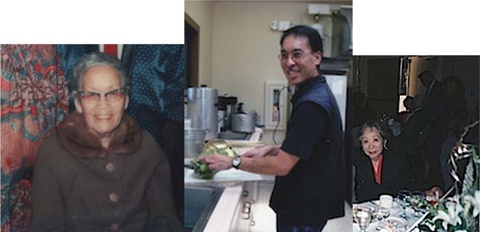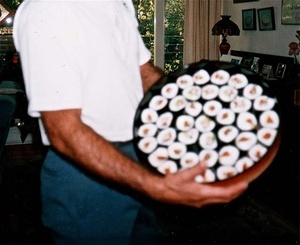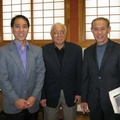What does your family call Thanksgiving stuffing? In our family, stuffing was called dressing. This food and cooking story entails a tradition that goes back three generations from my maternal grandma, Suye Sakoda to her daughter, Edna Ishikawa, and to me, Troy Ishikawa. Do good cooks run in your family? I hope so, because good cooking must be in our blood!
Having just said that, my mom was not always a quintessential cook. She developed her skills over the decades. Not surprisingly, she eventually built a career as a professional caterer and personal chef from the early-1960s to 2002. (So there is hope for everyone). She did not study at a tony cooking school, such as the “Le Cordon Bleu” or the “Culinary Institute of America,” however honed her technique and craft by practicing and learning from other experienced and/or fine cooks. She immersed herself in the odd class or two from professionals who did study at those schools. I remember her learning French cooking and also later how to use the Cuisinart.
Years earlier, she was also introduced to cake decorating. She was especially adept at creating and shaping roses. Each petal was a work of art. She made all of our birthday cakes from scratch from a recipe called, “Heavenly white cake.” As kids our favorite part was eating the stuck on crumbs that covered the pan (the recipe neither called for grease nor lined wax paper—most likely because cakes need to climb onto the side of the pan, so that they can rise). Mom knew nearly all guests wanted a rose made out of butter cream frosting so she shaped and squeezed out plenty of them.
However, my Grandma Sakoda preferred to bake “Betty Crocker” type of cake mixes. These box cakes were very popular after WWII. She was mighty partial to the “confetti” cake and later cherry cake. Grandma Sakoda was so enamored with “Betty Crocker” cake mixes; she brought a box cake every week to her Japanese bible study group at the Lincoln Avenue Presbyterian Church in Salinas during the 1950s.
Unfortunately, my mom didn’t learn how to cook from her mom. A couple of times, I heard the reason why. While growing up during The Great Depression, Grandma Sakoda frowned upon possible food wastage and hence allowing her daughters to experiment in the kitchen wasn’t in her game plan. Grandma Sakoda cooked for her large family, plus workers, and guests (meaning every meal had to be more than just edible, but delicious). She was especially known for her makizushi, a seaweed roll-type sushi layered with Japanese vinegar rice, cooked carrots, kampyo (a gourd cut into stripes and later cooked in dashi, a bonito fish, and kombu seaweed stock enhanced with shoyu, mirin, and sugar), tamago (slightly sweetened rolled egg), shiitake mushroom also cooked in dashi, beni shoga (pickled ginger), and unagi (broiled eel in a sweetened shoyu sauce). Unlike other farmer’s wives, she skipped the cooked celery, probably too stringy for her tastes (back then, she didn’t de-rib).
As a child, I disliked beni shoga, so Grandma Sakoda would roll one makizushi without. I believed she thought my “dislike” for pickled ginger was strange, since Japanese are suppose to inherently love pickled ginger. Not all! Thus, she would announce that this sushi roll was for me. Although as an adult, I like ginger, I still am not infatuated with beni shoga. I chalk my slight aversion to the sharp taste and fake red dye. In the old days, they used the shiso (perilla leaves) as they also add to color the ume-boshi (pickled plum).
In the 1920s, my grandma was hired as a cook by the Union Pacific railroad. She also washed their workers’ laundry. She was proud to work two jobs and thus doubling her pay. Through her Union Pacific job, she learned how to cook Southern fried chicken. This was always featured at her table. Most of all, I remember the juicy succulent taste and crispy golden skin, especially the chicken thighs. She fried the chicken in a cast iron skillet in about an inch of oil. It wasn’t fancy—just flour, salt, black pepper, paprika, and probably other seasonings. At my young age, I really wasn’t watching with a studied eye.
When my grandparents visited Japan in the early 1960s, they wanted to give a thank you and appreciation party. Grandma shopped at a butcher in Kokubu and saw that he had four whole chickens in his refrigerator case. She requested she would like to buy all of them. He looked at her and was caught off guard. He exclaimed that he would not sell her all of his chickens, but that she would be permitted to buy only one. He said that if she bought all of his chickens, there would be none left for other customers. She was no doubt “p.o.’d.” She explained that she was preparing for a party for her relatives and many people would attend. He still didn’t budge on his earlier decision, so she ended up buying just the one chicken.
As for myself, my earliest cooking memories started at age 4. I made sun jam, since I still wasn’t old enough to cook on the stove—that would have to wait till the following year. Now, you’re probably saying to yourself, “a 5-year-old cooking on a stove?” Yes. I learned how to cook eggs, but I wasn’t allowed to cook anything over 150-degrees, which was the first number on the dial. Returning back to making sun jam—in the summer, our family would pick ollallaberries at a “U-Pick” berry farm operated by the Gizdich family in Watsonville. I would crush the berries in a jar and allow the sun to cook them. Usually, I did this while sitting on the couch next to a picture window in our living room facing the southern exposure. I never ate the sun jam, but insisted for my dad to partake (most likely some cruel form of punishment). I knew the sun jam would taste awful because I probably omitted the sugar. My dad was a good sport and would eat the jam on bread, at least in my presence.
How did I learn to cook? By watching my mom, and asking lots of questions. In the kitchen, I learned about food chemistry, sanitation, and of course cooking. I didn’t really have to cook until I moved to university. By now, my repertoire included spaghetti bolognese sauce, baked teriyaki chicken, and pasta primavera. After university I moved to Japan and added some simple Japanese dishes: Mabo dofu (Chinese style knock off of savory tofu) and yaki-soba (seasoned fried noodle and vegetables), both taught by a hakujin (White) Canadian fellow teacher who married a Japanese izakaya (pub-eatery) owner. Funny thing, no Japanese person taught me how to cook their food.
A few years later, I befriended some Turkish friends and learned how to cook mercimek çorba (red lentil soup), yaprak sarma dolma, (stuff grape leaves), köfte (meat balls), and the famous, baklava. The tip is to add very little lemon juice late in cooking the syrup, never earlier.
My mom and I had a non-competing clause in the kitchen. She would never make the foods that I could cook. I would sometimes encourage her to make some of the foods that I learned, but she resisted. She knew how “territorial” some cooks can be.
My mom passed away 10-years ago. She always cooked a nearly traditional Thanksgiving dinner that we ate in the early afternoon à la East coast-style. After her passing, I cooked my first Thanksgiving dinner. I wanted to include all of our favorites: roasted Diestel turkey, pan gravy, Japanese sweet potatoes (yellow inside), cranberry-damson plum sauce, yeşil fasulye (Turkish green beans), kabocha-honey pie, and dressing or what most people call, stuffing.
The dressing recipe was originally from my Grandma Sakoda. I obtained a hand-written copy passed down by my uncle Sam Sakoda who incidentally shot the above photo. My grandma’s original Shiitake Mushroom Dressing recipe included the following ingredients:
1 loaf of bread—diced or pulled apart (the day before)
6 slices of bacon, chopped or use a food processor: gizzard, liver, and heart
1 onion diced
1 can of water chestnuts diced
6 shiitake mushrooms soaked to reconstitute and then diced
2 stalks celery, diced
Fry in 1/2 cube of butter until soften with salt, pepper, and poultry seasoning.
Add 1/2 to 3/4 cup turkey broth (water, neck bone, bay leaf, salt, pepper, parsley, and onion), simmer 1-hour.
Stuff turkey—do not pack. After the turkey is cooked, take out dressing and mix with left-over dressing (that was baked the last half-hour in the oven while roasting the turkey). Grandma would also include the turkey neck bone meat to the dressing. Nothing was wasted. The Japanese people call this, “mottainai.”
In my mom’s kitchen, her version of Grandma Sakoda’s Shiitake Mushroom Dressing added, omitted, or changed ingredients. Mom more or less changed ingredients annually. She liked to experiment or you could say, she liked to “refresh” her recipes so they would not become stale. She changed the “loaf of sliced bread” to a 1-lb. sourdough round, omitted the bacon, shiitake mushrooms, and water chestnuts, but added green bell pepper, chopped Italian parsley, and fire-roasted or boiled chestnuts.
While my version omitted both the bacon and giblets, I include my mom’s version of changing the bread to a sourdough and also added green bell pepper and chopped Italian parsley while additionally bringing back grandma’s shiitake mushrooms and water chestnuts and changing from butter to extra virgin olive oil. Neither my mom nor I included the turkey neck bone meat. A lot of extra work for a little pay off. My mom told me one time that her favorite dressing included a linguica sausage, but I didn’t like this type of sausage, so she never indulged.
We made changes because all of us are different in our tastes in food, but the tradition of Thanksgiving dressing or stuffing lives on. Last year, my cousin, Dannette Sakoda, uncle Sam’s eldest daughter inquired about Grandma Sakoda’s shiitake mushroom dressing recipe that I gladly shared with her the original recipe and my version, too.
© 2012 Troy Ishikawa










